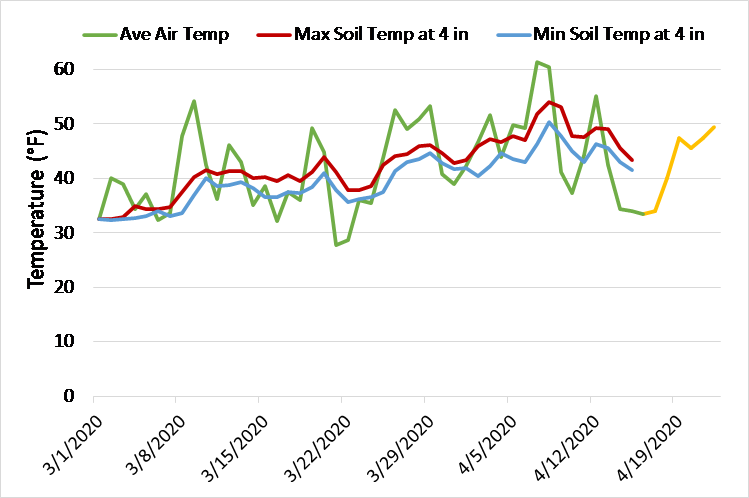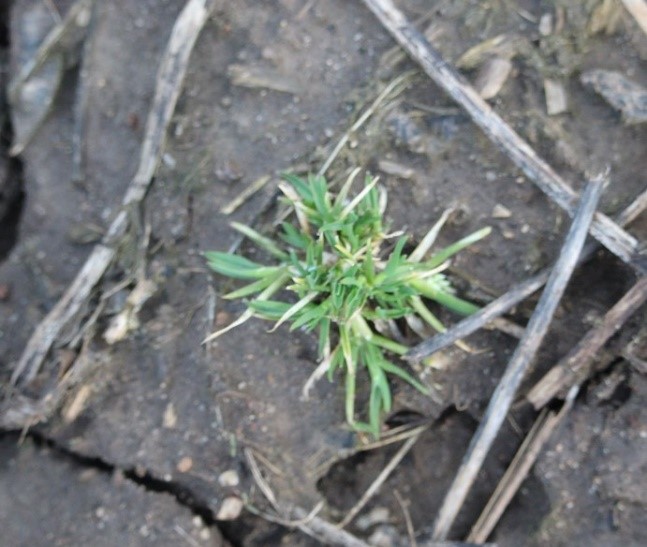Southwest Michigan field crops update – April 17, 2020
As field activities begin to heat up, temperatures are expected to cool down. Here are some things to consider for the agriculture community.

The infection numbers for COVID-19, the infectious disease caused by novel coronavirus, continue to creep up across much of southwest Michigan (Table 1). It is more important than ever to continue to practice social distancing, wear personal protective equipment (PPE) where appropriate and disinfect surfaces to protect yourself and members of your operation from the effects of COVID-19. Stay healthy, stay safe and stay productive as the planting season gets underway.
|
Table 1. Confirmed COVID-19 cases in southwest Michigan and surrounding counties, updated April 16, 2020. Retrieved from Michigan.gov Coronavirus | |||
|---|---|---|---|
|
County |
Confirmed cases |
Reported deaths |
Case fatality rate |
|
Barry |
20 |
1 |
5% |
|
Berrien |
133 |
7 |
5% |
|
Branch |
31 |
2 |
6% |
|
Calhoun |
119 |
4 |
3% |
|
Cass |
19 |
1 |
5% |
|
Eaton |
84 |
5 |
6% |
|
Ionia |
20 |
2 |
10% |
|
Kalamazoo |
118 |
8 |
7% |
|
Kent |
385 |
17 |
4% |
|
St Joseph |
23 |
1 |
4% |
|
Van Buren |
26 |
2 |
8% |
Weather
The eastern Great Lakes are the focal point for continuing cold conditions in the 6-10 day outlook (Fig. 1), with much colder than normal temperatures expected during the period. Soil temperatures (Fig. 2) were warming nicely before the current cold spell, but they should begin to approach 50 degrees Fahrenheit again toward the end of April or early May. Moisture conditions are expected to be slightly above normal, as areas in the northern Corn Belt are expected to dry out. The precipitation forecast (Fig. 3) is calling for only 0.5 in water equivalent or less in the region over the coming week. Above normal moisture levels are expected to be common in the southeastern U.S. These patterns are expected to persist through the 8-14 day period, with southwest Michigan near enough to storm tracks to the south and east to remain wetter than normal with cooler than normal temperatures. These outlooks will take us to April 26.
The 3-4 week outlook tends to show more active storm tracks across the northern sections of the country, including our area, but moderation to more normal temperatures. The good news is that, at least for now, we are not seeing the same pattern that we saw over the last couple of springs, which left us with significant planting delays.


Field conditions
While rainfall totals have been variable this spring, there has been some field work being conducted across the southwest region. Limited amounts of fall tillage were conducted last year because of wet conditions across the region. Some folks have been able to begin working on washouts and some ruts on drier fields. On this week’s MSU Extension Field Crops Virtual Breakfast, MSU Extension agricultural engineering specialist Tim Harrigan cautioned farmers about trying to remedy deep ruts this spring while soil moisture conditions are relatively high. He instead recommended doing light tillage to fit fields for planting this spring and saving deeper compaction remediation until after harvest when (hopefully) soil conditions will be better.
Winter annual weed growth has responded to the warmer and wetter conditions of a week ago, and fields have greened up substantially over the last week.
Pests on the move north
Purdue University entomologist John Obermeyer reports seeing significant moth flights in portions of Indiana. Significant armyworm captures were recorded in Lake (60) and Pulaski (31) counties in northwestern Indiana during the first week of April while “impressive” black cutworm captures were recorded at all but the Whitley (Northeast Purdue Agricultural Center) research station during that time period. This can be especially important for those folks that have wheat or other cereal grains planted. Armyworm is more likely to lay eggs in fields that are planted to cereal grains or have rye as a cover crop. Black cutworm moths tend to lay eggs in fields that have high levels of winter annual broadleaf weeds. Both species are deposited in our area when moths are sucked up by thunderstorm updrafts from fields to our south. The highest numbers are being seen in southern and central Indiana so far.
One other early season insect pest to keep an eye out for is white grubs. Asiatic garden beetle white grubs can be problematic for corn. Keep an eye out during spring tillage operations for high levels of bird activity following your tillage operations and get off the tractor to stretch your legs occasionally to check for high numbers of white grubs being turned up. The pests are likely to be up towards the soil surface right now feeding on winter annual or marestail seedling roots. Since there are no rescue treatments for these pests, it is important to detect fields with high levels of pressure before the field is planted and to apply soil insecticides in heavily infested fields.
Winter annual weed control/burndown for no-till fields
Temperatures and active weed growth can be important in the effectiveness of burndown herbicide applications. MSU Extension field crops weed specialists Christy Sprague and Erin Burns remind us that early season weed control is important to maintain high yield potential in both corn and soybean production. Tillage can also be effective at controlling winter annual weeds, but earlier is better, especially where there are high levels of annual bluegrass in fields. Annual bluegrass forms a thick mass of roots, which can form difficult to break apart clods, reducing seed to soil contact where this weed species is thick. Sprague will address early-season weed control topics on the Virtual Breakfast session on April 23.

Another important thing to consider before planting corn or soybeans is to review your herbicide application records for 2019. Because we had significant planting delays last season, many fields were sprayed later in the season than normal. You may want to review your herbicide programs and to look at the rotation restrictions for materials that were applied last season for weed control. This information is available in Table 12 in the MSU Weed Control Guide For Field and Forage Crops.
Crops
Several growers are trying early planted soybeans this year. Some growers in the region began planting soybeans last week. Early planted soybeans can have advantages in producing more nodes, making use of solar radiation during the longest days in the growing season, and being able to branch more to produce high yields at lower plant populations. Mike Staton, MSU Extension soybean educator, outlined things to consider when planting soybeans early.
One more thing to consider following two seasons of excessive rainfall amounts is that potassium can leach out of the root zone on sandy soils. Be sure to soil test regularly to make sure that you have adequate soil fertility.
RUP pesticide certification process changed due to COVID-19
The Michigan Department of Agriculture and Rural Development (MDARD) is offering private applicators the opportunity to recertify by taking an oral exam for the Private Core over the phone. MSU Extension also has developed a webinar review presentation so growers can prepare for the examination. Schedule a time to take an oral exam with MDARD.
Just released on April 17, 2020, Governor Whitmer’s Executive Order 2020-52 allows for the temporary extension of all three-year certificates for commercial and private applicators and registered applicators that were set to expire Dec. 31, 2019. Effective immediately, these certificates will be deemed unexpired “until 60 days after the end of the declared states of emergency and disaster.” Certified and private applicators with temporarily extended certificates should obtain a copy of Executive Order 2020-52 and be able to present it, along with their driver’s license and expired certification card, upon request.
This executive order does not apply to certificates that expired prior to Dec. 31, 2019, nor does it apply to those seeking certification for the first time. Those with certifications that are being temporarily extended will need to retest within the 60 days following the termination of the state of emergency under Executive Order 2020-33. MDARD plans to significantly increase exam capacity during the 60 days and Metro Institute will resume computer-based testing where possible.



 Print
Print Email
Email